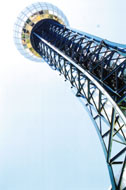
Comment
on this story
|
|

Symbols of our city, its heritage, and its quirkiness
by Jack Neely
Ask somebody in Omaha or Cincinnati to name something Knoxville's known for, and they're very likely to draw a blank. Knoxville is not a city known for its icons. Which is all the more reason to celebrate the ones we have. And we definitely do have them, places that serve as handy symbols for something or other, lights to aspire to and the butts of jokes.
There are lots and lots of them, of course. Everyone has his or her own. For some, it's the JFG sign at the south end of the Gay Street Bridge. For others, the old marble gazebo at Chilhowee Park. Following is an incomplete inventory of Knoxville's icons: the things that, for better or worse, don't exist anywhere else and find themselves, willfully or not, representing this peculiar city.
Sunsphere
Once a public restaurant and observation deck, now more or less an office building elevated a couple hundred feet above the convention-center rabble, our city symbol is off limits to most of us. But it's undeniably there, and inside those cars with Ohio plates on the interstate, it's a safe bet that it is, for a few seconds, the chief subject of conversation among Knoxville passers-through, most of which go something like this: What the hell is that?
It's the Sunsphere, of course, and it is, like it or not, the most conspicuous legacy of the 1982 World's Fair. Probably the handiest symbol of Knoxville, it's both loved and hated, appearing in numerous ads for the city and its businesses. The most obvious icon may also be the most unlikely. This city distinguished from most other American cities by its high amount of rainfall is represented by a giant golden sun. To skeptical Druids, perhaps, it's a reminder that the sun will once again return to our kingdom. After 21 years, it and the embattled Tennessee Amphitheatre are in fact the only buildings left on the fair site that are relics of the fair, and the days when we were visualizing a 21st century without air pollution and without dependency on foreign oil and foreign political doctrines.
Some, inevitably, call it phallic, of course, in spite of the fact that the same wags might often call it testicular, as in the oft-repeated proposed motto: "We've got balls." It might take a team of anthropologists to determine once and for all whether it's phallic, testicular, or something else altogether.
It was designed by a Knoxville architectural firm with the incongruous name of Community Tectonics, who were approached by fair organizers in 1979 to come up with a signature design for an energy-related exposition. (The design was challenged by another designer, Marc Cardoso, who claimed that he had submitted a similar design back in 1977, but courts found in favor of CT.) They wanted to build an observation tower/restaurant that would be a "monument to the sun," the source of energy on Earth.
Promoters claimed the Sunsphere to be "the first major spherical building, and the major architectural structure of this decade." The sphere itself, originally to be 86.5 feet in diameter, to symbolically represent the 865,000-mile diameter of the real sun, was amended to only 74 feet due to fears of cost overruns. They overran anyway.
At 266 feet tall, it's less than half as tall as some other World's Fair theme structures; architects of the Sunsphere explained that they wanted to keep it low so visitors could still make out the fair site below.
The restaurant, operated by the Hardee's corporation, turned out to be a disappointment to some, sneered at as overly expensive, cramped, "surprisingly ordinary," and not particularly good. The cuisine was dominated by middle-American Swanky: the cheapest thing on the menu was the Sunburger. A post-fair restaurant featured a drink called the Sunburst, a concoction of rum, orange juice, grenadine, lime, and vanilla-flavored Nassau Royale. They all flopped. Some wondered whether there was something about the layout of the place that made it unlikely anyone could fix a good meal up there.
However, it has been a popular center of attention. In 1987, it became a giant jack-o-lantern, until the city noted that the WIVK that formed the mouth made it, technically, an illegal billboard. In 1990, a rock'n'roll band featuring a grand piano played on the very top. In 2000, two climbers scaled the tower and camped, unfurling an Earth First banner.
The Sunsphere, whose construction was variously estimated at $6.5 million and $8.5 million, was appraised a couple of years after the fair for only $750,000 which seemed, in itself, to symbolize something about the Fair and what it was supposed to do for us.
Neyland Stadium
It doesn't matter whether you're a football fan. Neyland Stadium with a sellout crowd is one of the most impressive sights you'll see here. If it's no longer the largest, it's still one of the largest football stadiums of any kind in America. Many people around the world—people in New York or Los Angeles, for example—never get the opportunity to see 110,000 people in one building. You might think they'd look nicer dressed in some other colors, but you can't have everything.
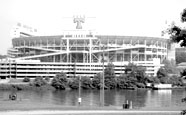
It began, as many big things do, modestly, as a little field known as Shields Watkins, whose chief advantage over its Cumberland Avenue predecessor, Wait Field, was that it was flat, and had no exposed stone outcrops. The project began in 1919 with a $22,500 gift from an elderly banker known as Col. William Simpson Shields for an "athletic field." Born in Grainger County before the Civil War, the one-time farmer had opened the City National Bank in Knoxville in the 1880s, a lending institution expressly aimed at a neglected market, the young, unproven speculator. He had done well. Shields had been spending his later years supporting the career of his often-controversial younger brother, U.S. Sen. John Shields, who had alienated President Wilson, and even much of his constituency, with the unexpected fierceness of his opposition to the League of Nations. W.S. Shields was apparently not a UT alum, but was a trustee and, as a resident of Melrose Place, a neighbor.
The university matched Col. Shields' gift, and went to work clearing what had been seven acres of rough terrain near the banks of Second Creek. Led by a young civil engineering prof—and former Vol standout—named Nathan Dougherty, a group of faculty and student volunteers cleared and graded the plot. The prospective field was scarred by a deep ditch; workers filled it in with excavation dirt from the Hill, where Ayres Hall was being built simultaneously.
Finished in early 1921, it was named for old Col. Shields and his wife Alice, whose maiden name was Watkins. The first ball game played on it was not football, but what was still a more-popular sport in Knoxville, baseball. Cincinnati beat UT. The first football game, a UT victory over Emory and Henry, followed several months later. That first season on the new field, the Vols still wore their traditional black jerseys with subtle orange-and-white armbands.
It grew in stages, but exploded in size after the arrival of a young Texan, an army officer with a reputation as a genius of strategy, Coach Robert Neyland. By 1948, about 20 years after Neyland's arrival, Shields-Watkins Field was nearly 15 times its original size, with more than 46,000 seats, reaching the famous horseshoe shape it would have for decades. Open toward the Hill, where sentimental alumni cast their eyes as they sang the alma mater, the stadium democratically afforded a fine view to dozens of students who could sit in the grass and watch the game for free.
It was not known as Neyland Stadium until 1962, when the stadium part was renamed for the dying general who had invented Volmania. That year also saw the first-ever addition of an upper deck. The name change became official just after Neyland's death, at the Alabama game. He didn't live to witness one of the Vols' worst seasons in modern history: the Vols lost that inaugural game, as they did most of their games that season.
There was always next season, though, and as the Vols' fortunes improved, the stadium got only larger, until that brief moment in the late '90s when it was the largest stadium in America. No one has ever called it the prettiest, but some historically-minded architects admire the fact that we can still see the old masonry stadium, as it appeared during Major Neyland's era, beneath the steel superstructure.
The Duck Pond
Just calling it that can get you in trouble with the Fountain City elite, which are legion. They insist that the duck pond is, in fact, Fountain City Lake. They should, however, be forgiving of those who have some difficulty with that designation, like those familiar with other lakes, like Lake Pontchartrain, say, or Lake Michigan.
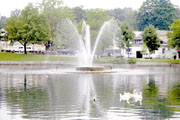
Even the phrase "Fountain City" is a little bit of a misnomer: unlike most older neighborhoods in town, Fountain City was never any sort of a city, and it never had what most of us would recognize as a fountain. It began as a rural tent-revival spot at "the Fountainhead" where First Creek springs, as if by some Old Testament miracle, from a rocky hillside. Safely shielded from sooty, boozy Knoxville by Sharp's Ridge, the Fountainhead developed a reputation for cleanliness, health, and temperance. When it was big enough to merit its own post office, the U.S. Post Office objected that there was already a Fountainhead, Tenn., even if no one in East Tennessee ever heard of it. So around 1890 the locals settled for the more cosmopolitan-sounding Fountain City.
The duck pond is, in fact, all that remains of the three-story Fountain Head Hotel, an extravagantly luxurious, alcohol-free resort which was widely known and very nearly gave temperance a good name. Fountain City was "where the morals are as pure as the bracing atmosphere and life-giving water," and to emphasize that sentiment, in 1891 they built a large pond in front of the hotel. Tradition has it that it's roughly heart-shaped because Fountain City had a reputation among Knoxvillians as a place for the young and sober to fall in love.
Well, the hotel was nice while it lasted, with running water in all the rooms from clear First Creek, but in the more practical 20th century it became a sanitarium, and then burned to the ground. The duck pond, and the name Hotel Avenue, are all that remain.
Market Square
Knoxville had a public market place along Main Street as early as 1816, but it wasn't until 1853—150 years ago—that two public-spirited young gentlemen, Joe Mabry and William Swan, donated this flat field—previously a corn field, by some accounts—to be the official Market Square. It has changed radically over the years—during the Civil War and Reconstruction era, the  market house here looked like a twin pair of quonset huts, and the overlarge Victorian Market House was added in 1897. Meanwhile, the Square itself developed with a mixed-use diversity unmatched in any other block in East Tennessee. It has hosted groceries, bowling alleys, cinemas, our city hall, our police station, furniture stores, stove factories, butcher shops, boarding houses, upscale residences, brothels, department stores, newspaper offices, bicycle shops, whiskey bars, ice-cream saloons, private eyes' offices, Greek cafes, record stores, Duke Ellington concerts, and Roy Acuff hootenannies. Described in several novels, it's been praised by Carl Sandburg and Norman Mailer and has been the subject of a famous Henri Cartier-Bresson photograph, and that was before any of them knew it was where Adolph Ochs, the founder of the modern New York Times, began his career in journalism. market house here looked like a twin pair of quonset huts, and the overlarge Victorian Market House was added in 1897. Meanwhile, the Square itself developed with a mixed-use diversity unmatched in any other block in East Tennessee. It has hosted groceries, bowling alleys, cinemas, our city hall, our police station, furniture stores, stove factories, butcher shops, boarding houses, upscale residences, brothels, department stores, newspaper offices, bicycle shops, whiskey bars, ice-cream saloons, private eyes' offices, Greek cafes, record stores, Duke Ellington concerts, and Roy Acuff hootenannies. Described in several novels, it's been praised by Carl Sandburg and Norman Mailer and has been the subject of a famous Henri Cartier-Bresson photograph, and that was before any of them knew it was where Adolph Ochs, the founder of the modern New York Times, began his career in journalism.
All the while, it had open areas where farmers sold their produce. If we don't get in some tables with fresh tomatoes and corn and collards this summer, Market Square's 150th year may be the first ever to have no farm-produce sold on the premises.
The Strip
Strip has become a common word to describe any commercial area. You hear about strip malls, strip developments. A lot of interstate exits have something called "the Strip," and many of them have versions of the same chain restaurants you'll find at the western end of Cumberland Avenue. It wouldn't seem a nickname with any particular color or mystery to it unless you knew the story.
Cumberland Avenue, once mostly residential and generally grand in scale, became more and more commercial beginning in the early 20th century, first with businesses that served mainly the neighborhood, like Brownie's, the original Quarterback, and the lamented Booth Theatre. By 1950, most of Cumberland from 17th Street west to the trestle was commercial.
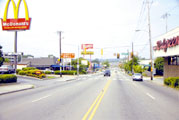
In the 1960s, that stretch of Cumberland grew a reputation as the commercial center for one of the South's largest universities, and the subculture it spawned. It hosted record stores, bookstores, hip-clothing stores, and rock'n'roll nightclubs, but also a number of places and individuals where you could dependably find primo dope. Certain hippies, eager to coin jargon the squares wouldn't understand, began to call the place "the Strip."
It wasn't widely known by that term until 1971, when the west end of Cumberland became the focus of a major drug bust, orchestrated by detective and future Mayor Randy Tyree, known as Operation Aquarius. Almost certainly the biggest drug bust in Tennessee history, it netted about 200 drug-related arrests (one of the later ones was a reporter for the conservative Knoxville Journal who had been covering the operation). It was, perhaps, the most publicity the neighborhood had ever gotten for anything. After news accounts patiently explained to suburbanites that "the Strip" was hipster slang for old West Cumberland, it became common usage even among business owners and establishment types.
It took on new meaning, of course, in 1974. Some heard the old hipster nickname as a command. It was in the spring of that year that an estimated 5,000 people on Cumberland Avenue took their clothes off. According to some reports, during certain evenings that spring, most of the people between 17th and the trestle were naked. They lounged on the street, inside bars, and on top of roofs, prompting Walter Cronkite to designate Knoxville as the "Streaking Capital of the World."
Kingston Pike
Knoxville's busiest commercial street is more interesting than it looks. First it was just the turnpike, dating back to territorial days, that went from the capital to Kingston, the busy little riverport near the Indian territory: a narrow dirt road, scary in spots, and reputedly haunted. It was out here in 1803 that Andrew Jackson and John Sevier met for their abortive duel.
By the 1920s, it was paved for automobiles, and all the part now known as Kingston Pike was the junction of two major cross-country thoroughfares, the Dixie and the Lee Highways, used both by Chicagoans bound for Florida and Washingtonians bound for the Big Easy. The two highways formed a jagged X that stretched across the eastern United States, and Kingston Pike was the center of it. The farms that had lined Kingston Pike before 1920 began grudgingly to share frontage with restaurants, drive-ins, hotels, motels, motor courts, and tourist camps that served the tourist trade. A couple dozen buildings along the pike, like the one that houses Naples, were built to serve that tourist trade.
But then came ORNL, and I-40, and lakefront residential development: By the 1960s, the pass-through tourists were shifting to the interstate, but Kingston Pike found itself at the white-hot center of the West Knoxville juggernaut. It became for automobile-oriented retail what downtown had long been for pedestrians, and perhaps the most worshiped of all Knoxville icons.
Old Gray

It might sound like the name of a beloved mule, but Knoxville's most elaborate Victorian cemetery was once the one place where Knoxville's elite were willing to be caught dead.
It was literally outside Knoxville's city limits in 1850, a virgin forest when it was first designated, in response to the international trend to bury the dead not in urban churchyards, sometimes associated with plague—but in pristine countryside settings.
It was called, simply, "Gray Cemetery" until New Gray opened on Western in the 1890s. The original name was suggested by Sarah Reese, then wife of UT president, Judge William Brown Reese. She was an admirer of Thomas Gray, the 18th-century English poet famous for the famous "Elegy Written In a Country Churchyard."
The graveyard has had its ups and downs, and has lost some of its own icons to theft, weather, and disinterment, among them the elaborate iron Albers Fountain, which finally rusted apart in the 1950s. And there's concern about the neighborhood, which seems to be consolidating its status as the region's institutional center for the homeless. But it's still a beautiful place for a walk, or to read a melancholy old English poem.
"Old City Hall"

It looks like an old city hall, sure enough, but like a lot of other local icons, its name is misleading. This handsome brick building overlooking Henley Street and Summit Hill, built in 1848, is well-known to many. Longtime Knoxvillians over 40 remember when it was City Hall. But Knoxvillians over, say, 100, remember when it was the Tennessee School for the Deaf. It served as that school's original campus in the days when the institution was known, less graciously, as the Deaf and Dumb Asylum. It was a major institution that rivaled the university in prominence. Asylum Avenue, once among Knoxville's best-known streets, was named for it.
The building housed TSD's predecessors for about 75 years—longer than its later use as City Hall. It's mentioned as it appeared in 1916 in James Agee's novel, A Death In the Family. The city, which had previously concentrated its governmental offices on Market Square, moved in in the early 1920s, then out upon the completion of the City-County Building in 1980. Today, the building is owned by TVA and occupied chiefly by the Knox County Chamber Partnership.
The Hill
The knob alongside Second Creek had no academic associations in the 1790s, when there was a graveyard up there; one which was thoroughly forgotten by 1826, when trustees of downtown's tiny institution of higher learning, then known as East Tennessee College, broke ground for a building up there, citing the proximity of a nice stream nearby. And as they dug into the top of the Hill, they found human bones.
From its original occupation in 1828 until about a century later, the university was almost entirely confined to the Hill. Today, some students get degrees without setting foot on the place, but as the only part of campus that looks like a college campus, it's still the chief place for a UT photo op—and it's still there in the opening line of UT's beloved Alma Mater: "On a hallowed hill in Tennessee...."
And no, it was never known as Rocky Top. That's somewhere else.
Island Home
Perez Dickinson, the Massachusetts-born merchant prince—a close cousin of the younger poet, Emily—bought one of the area's larger river islands, then built a large brick house on the mainland nearby. He lived on Main Street, downtown, but called this his Island Home. There are a variety of stories about the place, most of them asserting that Dickinson built it in homage to his young bride, Susan, who came down from the Bay State to marry him, but died tragically young, in 1845. The most Gothic of the stories holds that Dickinson was building the house for her as a surprise gift, one that she never lived to learn about; other stories imply that he didn't build it until some years later. (He didn't even buy the island that became known as Dickinson Island until 1869.)
In any case, Dickinson himself allegedly never spent a night there in his long life. So Island Home was neither on an island, nor anybody's home. But the 600-acre property saw use as an experimental show farm run by a Swiss expert—it yielded, among other wonders, a famous half-ton hog. It hosted a coleus garden, said to have contained a marble plaque with an alleged quote from his talented but still not widely known cousin: "For pulling fruits without the gardener's leave / Mankind was ruined by our Mother Eve." Dickinson's Island Home parties for UT's graduating class were legendary. Dickinson died in 1901, at the age of 88, after which his property was redeveloped as the new campus of the Tennessee School for the Deaf, the Island Home neighborhood, and, on the island that still bears Dickinson's name, the Island Home Airport.
The Mayfield Cow
Call her Maggie. She's 26.5 feet long, and when she's wearing her detachable horns, she's 15.5 feet tall. She's a fiberglass Jersey cow, and her only job is to promote Mayfield's milk.
Mayfield's Operations manager Ted Murray always speaks of her in the feminine, as he should. Mayfield now has a regular herd of giant cows: nine that are Maggie's size (in fact, they're all called Maggie, too), not counting two smaller ones. The Knoxville Maggie is the first, and oldest in the family. Murray doesn't remember exactly who manufactured Maggie, but thinks it was an outfit in Wisconsin.
Senior classes and scout troops have been posing with the big bovine since 1968. "We're pretty liberal with her," says Murray. "I book her on a first-come, first-serve basis."
Like any other rock stars, she spends most of her time on the road, toted around to various functions on a trailer. The years have been pretty kind to her; at least, she hasn't suffered the fate of some of her sisters. The Athens Maggie was tragically beheaded, as a result of an uncalculated highway underpass. "She's had several facelifts," Murray admits indelicately. Once, the wind blew her over. "We took her to Lusk's Body Shop," he says. "And she's had her horns replaced a couple of times."
Murry says he's already had to turn down dozens of vacation Bible schools. If you or your group want a date with her, lots of luck. She's already booked through the end of the year.
Blount Mansion
You could call it Knoxville's original icon. The Knoxville home of William Blount, signer of the U.S. Constitution and President Washington's governor of the federal Southwestern Territory was built in 1792 and said to be the first frame house west of the Appalachian Mountains (presumably excluding New Orleans). It's no mansion by modern standards, but was built to impress in a time and place when something as simple as plate glass could astonish the untraveled. The Cherokee were so impressed with its windowpanes, rarely seen in this part of the frontier, that they called it The House With Many 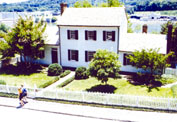 Eyes. Some of its accoutrements served to console Blount's luxury-loving wife, Mary Grainger, for whom both Maryville and Grainger County are named. Though James White and a handful of others were living here a few years earlier, it was William Blount's presence that assured Knoxville of a special status among all the shaggy forts and stations strewn across the wilderness. The Blount house was a fancy frame house and, no matter how small, a mansion; and because it was here, Knoxville was a territorial capital and therefore, no matter how small, a city. Eyes. Some of its accoutrements served to console Blount's luxury-loving wife, Mary Grainger, for whom both Maryville and Grainger County are named. Though James White and a handful of others were living here a few years earlier, it was William Blount's presence that assured Knoxville of a special status among all the shaggy forts and stations strewn across the wilderness. The Blount house was a fancy frame house and, no matter how small, a mansion; and because it was here, Knoxville was a territorial capital and therefore, no matter how small, a city.
Blount Mansion hosted an array of Cherokee chiefs, even fugitive French noblemen (like future Citizen King Louis Phillippe). It's best known as the site of some of the drafting of the state constitution in 1796. Later on, of course, Blount hid out here when he was a U.S. senator on the lam from a treason charge connected to his bizarre plot to conspire with the English to make Spanish-held Louisiana a British colony. He would have been out of place in the 19th century; he died here in the house in 1800.
It wasn't known as Blount Mansion for most of the 19th century. It was, among other things, the home of Samuel Beckett Boyd, mayor of Knoxville in the 1850s, and the refuge of his errant cousin, the Confederate spy Belle Boyd. It had fallen into disrepair as a slum, proposed for demolition in 1925 to serve Knoxville's sudden need for automobile parking, when Mary Boyce Temple, a Vassar-educated philanthropist who lived down the street, wrote a check to save it. Today, it's the only building in Knoxville that has earned the rarely granted Historic Landmark status.
James White Fort
The oft-honored James White—Knoxville's titular founder, whose name graces a wide parkway and a civic auditorium—is otherwise not very well known, even to historians. We don't know what he looked like, or much about what he thought. We know he was a pretty tall man, unusually religious for his time and place, that he established a fort here in 1786 and lived in it, at least part-time, for about 14 years before retreating to the countryside, perhaps weary of, or appalled by, city life.
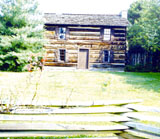
The fort is well maintained as a museum of life on the frontier as it was lived, albeit briefly, in Knoxville. (Less than a decade after White built his fort in the wilderness, the Indian threat had passed, and Knoxville was a capital city with a newspaper, a college, and stores that stocked merchandise from around the world.)
The fort is a reconstruction, of course, with its stockade of sharpened logs, employing some old cabins found elsewhere in the region. Whether the house in the southwest corner is substantially or partly James White's ca. 1786 house is an article of faith. It was used on its original location, without particular reverence, for a century or so after White gave it up, as a kitchen for another house in a low-rent neighborhood of Clinch Avenue. Then it was moved to South Knoxville for a few more decades as a suburban residence.
It would be interesting to carbon-date these logs: it's just possible that some of them were hewn by White and his men in the 1780s. However, the plaque on the wall, however well-intentioned, constitutes a bald-faced lie. This is not the site of the original White's Fort. That was where this plaque used to be mounted, on the site of the State Street Garage, near Clinch.
The Chilhowee Park Bandstand
Known by several other names in the Victorian era, Chilhowee Park was one of Knoxville's chief attractions a century ago, a site of outdoor dramas, agricultural fairs, baseball games, and classical-music festivals; it's not surprising that it was the destination of East Tennessee's first electric streetcar in 1890. When Knoxville decided it was big enough to put on major expositions, like the Appalachian Expositions of 1910 and 1911, and the even more extravagant National Conservation Exposition of 1913, Chilhowee Park was the natural site. Attended by over one million, it was the biggest party before the 1982 World's Fair, and in its impact, may have been more significant.
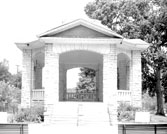
Expositions, of course, demanded impressive architecture, and Chilhowee Park became, for a time, a small city of impressively large buildings: the Liberal Arts and Machinery Building, the Negro Building, the Fine Arts Building, the East Tennessee Building. One by one, they all disappeared: the grand old Liberal Arts and Machinery Building went up in a terrific fire in 1938.
After that, all that remained of Knoxville's grand era of expositions was one marble gazebo. Built for the 1910 exposition, it hosted an unnumbered stream of orators, the likes of William Jennings Bryan and Teddy Roosevelt. Then we ignored it for years, as the modern world of Tennessee Valley Fair sideshows and corndogs swirled around it. The Fair renovated it as a Bicentennial project in 1976, but at most fairs the bandstand was rarely the center of attention, serving, one year, as a shelter for live chain-saw sculptors. Today, the old Edwardian bandstand is, fittingly, a centerpiece to the recent redevelopment of Chilhowee Park.
The Old City
Is a nickname of relatively recent vintage and, like many of our icons' names, a bit of a misnomer. It may have Knoxville's biggest collection of Victorian storefronts outside of Market Square, but it's technically one of the newer parts of what we know as downtown.
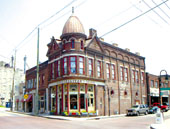
Most of what's considered to be the Old City today was on the swampy, flood-prone underdeveloped outskirts of town until its annexation in 1852, when the city of Knoxville was concentrated up on top of the plateau, mainly south of Union Avenue. What changed things was the railroad. After more than 20 years of effort, the first railroad, a combination of north-south lines that became known as Southern, arrived in Knoxville in 1855. Until the L&N opened half a century later, the region's main depot was right down here. Development boomed. It remained a patchwork area for years, partly the business district of the ethnic neighborhood known as Irish Town. Jackson Avenue was known for its wholesale houses. Central Avenue, then called Crozier but better known as the Bowery, was known for its sin. Later, as segregation got tighter in the early 20th century, it became black Knoxville's downtown. Much of it was abandoned by about 1980, when preservationists like Kristopher Kendrick began working with entrepreneurs like Annie DeLisle on bringing Knoxville back to a near-forgotten part of town. There was a movement to call it "downtown" as opposed to Gay Street's "uptown"—there's some historical precedent for that—some called it "downtown" around 1900. By most accounts, it was Kendrick who began calling it "the Old City."

July 3, 2003 * Vol. 13, No. 27
© 2003 Metro Pulse
|





